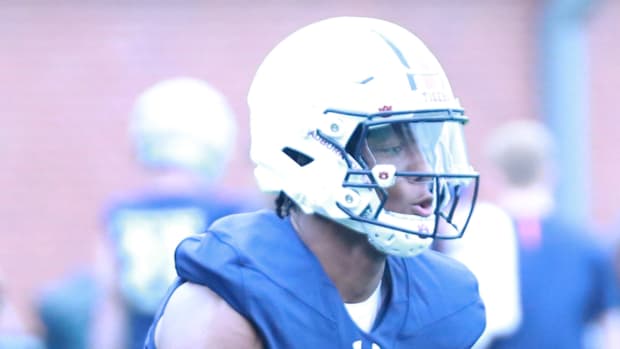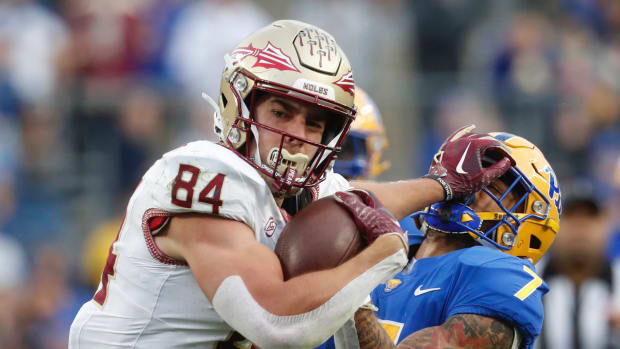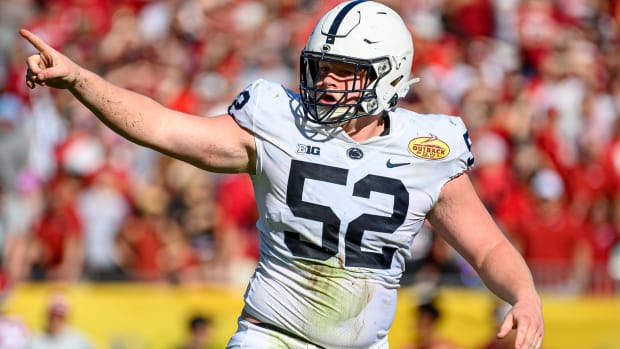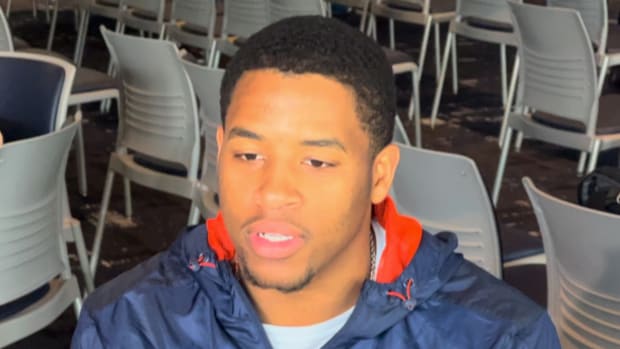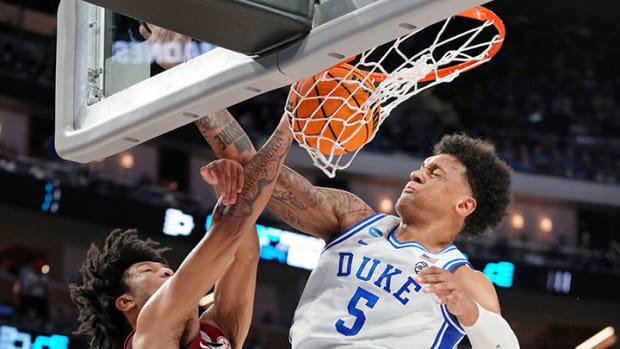NCAA loses in O'Bannon case, but hope for the association remains
After she spent most of a 99-page ruling thrashing the NCAA for its pitiful defense of what it purports to be its guiding principles, U.S. District Judge Claudia Wilken threw the embattled association a lifeline. It’s a thin one, and it will be heavily argued in court in front of Wilken and others in the future. Still, it gives the NCAA a fighting chance.
Yes, the NCAA lost to former UCLA basketball star Ed O’Bannon, his fellow plaintiffs and his army of attorneys. Wilken’s ruling on Friday in the O’Bannon v. NCAA case declared the association’s rules against paying student-athletes for the use of their name, image and likeness (NIL) rights to be violations of the Sherman Act from both a monopolistic (seller’s) and a monopsonistic (buyer’s) standpoint. She issued an injunction -- one which the NCAA and its schools must adhere to even while appealing -- that will make illegal any rules that ban payments for name, image and likeness rights in television broadcasts and video games.
However, Wilken did not fundamentally change the business model for major college sports -- even though she could have. This is a defeat for the NCAA and the schools, but it could have been much, much worse.
First, let’s get the bullet points out of the way. Here is exactly what Wilken ruled.
- The NCAA and schools may not make rules capping the amount of a scholarship below the actual cost of attendance. In the big-money corner of college athletics, this is not a big deal. The NCAA’s Division I Board of Directors voted on Thursday to allow the five wealthiest conferences (ACC, Big 12, Big Ten, Pac-12 and SEC) an autonomy provision that essentially allows them to create rules to govern themselves. Those leagues, flush with television cash from contracts signed by network honchos who thought they were buying the name, image and likeness rights of the participants, were already going to raise the value of the scholarship to the full cost of attendance. Was this done in response to all the lawsuits against the NCAA? Of course. But it means a framework is already in place to comply with this section of the ruling.
- The NCAA may not make a rule banning schools from creating a trust for athletes using money from the sale of NIL rights. This will allow schools to pay equal shares of NIL money to scholarship athletes each year, and the athletes may collect it after their eligibility expires. Wilken also ruled that the NCAA and schools may cap this amount, but that cap can be no lower than $5,000 for every year an athlete remains academically eligible. Wilken wrote, “Schools may offer lower amounts of deferred compensation if they choose but may not unlawfully conspire with each another in setting these amounts.” In other words, the schools can’t make a handshake deal to pay $2,000 a year. The ruling is designed to force competition in this marketplace, and if schools don’t want to break the law, they will compete. Let's assume they will not agree on a cap higher than Wilken's minimum, because why would they spend more money when they don't have to? If the SEC schools decide they want to pay $5,000 per athlete each year, and the Big Ten schools only want to pay $4,000, then the SEC has a recruiting advantage. Expect the deferred payments to be roughly similar among peer athletic programs. They’ll be highest in the Power Five leagues, lower in the other five FBS conferences and even lower or nonexistent in the other NCAA divisions and subdivisions. This ruling goes into effect for athletes in the next full recruiting cycle, so the recruiting class of 2016 will be the first group of freshmen to take advantage of the new rules.
Yet, here’s what Wilken didn’t do: She didn’t ban the NCAA from creating any rules that ban athletes from selling their name, image and likeness rights individually. She also wrote, “The NCAA has produced sufficient evidence to support an inference that some circumscribed restrictions on student-athlete compensation may yield pro-competitive benefits.” This is the ray of hope for the NCAA and the schools that the price-fixing scheme they’ve spent more than 100 years building won’t be completely undone by the courts.
Though Wilken placed little stock in the results of a survey by the NCAA that found respondents would be less likely to watch college sports if the players were paid, she did seem to put serious stock into statements by NCAA witnesses such as television consultant Neal Pilson and Stanford athletic director Bernard Muir that paying athletes a smaller amount wouldn’t change fans’ feelings as much as paying athletes a large amount would. At one point, Wilken also mystifyingly seemed to agree with the NCAA that it must “protect” athletes against “commercial exploitation.” This is a federal judge essentially saying that an adult American must be protected from someone giving him or her a legal (according to the government) market-driven payment for being good at something the market considers valuable.
That didn’t make much sense, but one of Wilken’s other justifications did. She wrote the plaintiffs didn’t prove there would be any effect on the market for individual name, image and likeness rights with regard to television broadcasts or video games. In other words, ESPN wouldn’t compete with Fox to buy the NIL rights of only UCLA quarterback Brett Hundley. Both networks would negotiate a price for every member of the teams they might televise. From a practical sense, because this is how most college athletics TV contracts are negotiated, this type of negotiation would be done on a conference-by-conference basis. To get Hundley’s NIL rights, networks would secure the NIL rights for all of the Pac-12’s players, and each Pac-12 school would then distribute the fees to the players.
Wilken could have chosen the nuclear option, but instead she addressed the very narrow issue the O’Bannon plaintiffs brought before her. In the process, she annihilated many of the NCAA’s pet arguments. The “Yes, But Amateurism” and “College Is Good” arguments favored by the NCAA at trial were dismissed completely. It won’t be wise for NCAA attorneys to build future defenses upon them. Rather, they’ll have to double down on their attempts to prove Wilken’s supposition that the rules offer a slight pro-competitive advantage to the consumers of college sports. That is their only chance against Jeffrey Kessler.
Kessler is the sports labor attorney who helped bring free agency to the NFL, and he has a case pending (Jenkins v. NCAA) that seeks to gut the NCAA’s entire rulebook. It doesn’t allege a price-fixing scheme with regard to name, image and likeness rights; it alleges a price-fixing scheme that restricts athletes from receiving what the market will pay them. It seeks to open the market for players as wide as it is open for coaches. At the moment, the Jenkins case is rolled into a consolidated suit in Wilken’s Northern District of California. However, it is likely headed back to New Jersey, where it was originally filed in March. “Kessler is the biggie,” one Power Five AD texted on Friday after learning of the O’Bannon verdict.
Federal judge rules against the NCAA in landmark O'Bannon antitrust case
Wilken stripped away most of the NCAA’s shopworn arguments, but she left one potential defense against Kessler in the Jenkins case. Of course, she also showed Kessler exactly what to attack. So, don’t be surprised if a survey-taker makes calls in the next few years asking people how they feel about the compensation of college athletes. If the question tries to lead respondents to say they would stop watching if athletes get paid, that caller probably works for the NCAA. If the question tries to lead them to say they wouldn’t care whether athletes got paid, that caller probably works for Kessler or one of the other attorneys suing the NCAA.
Meanwhile, the NCAA will likely fight the O’Bannon ruling in the Court of Appeals for the Ninth Circuit. “We are reviewing the full decision and will provide further comment later,” NCAA chief legal officer Donald Remy said in a statement on Friday. It’s possible the appeals court may rule before any of the new guidelines would take effect. It’s also possible everything Wilken ruled will stick. It’s also possible the NCAA and its new lobbying team will get some legislative relief from the U.S. Congress, but that could get derailed for any number of reasons. For now, the schools will have to figure out how much to pay players for their name, image and likeness rights. And they won’t be allowed to conspire to make that number $0. They’ll have to compete to offer the most attractive package they can afford, which was precisely Wilken’s point.
The NCAA lost the O’Bannon case, but its way of doing business survived. In her ruling, Wilken simultaneously offered the best hope for that business model’s survival and the roadmap for its destruction. The ultimate winner will be the one with best lawyers.

